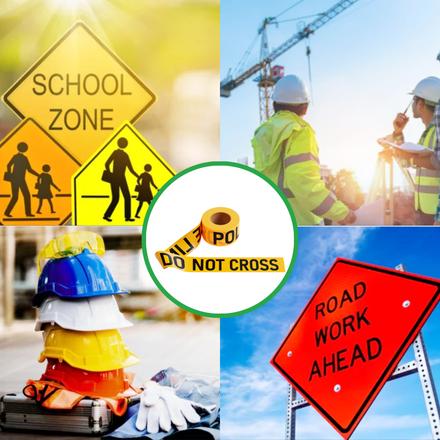If you work in a safety or construction industry, you may have heard the term "caution tape" used to refer to a wide variety of barrier messages, even ones which don't include the word "caution". Just as Americans might be in the habit of using the word "rollerblades" when referring to inline skates of any kind (or a plethora of other hyper-specific misnomers), people have also come to use the term "caution tape" to refer to barricade tapes of any kind.
What is Barricade Tape?
The truth is, what people are often referring to is more accurately called "barricade tape". While "caution tape" refers specifically to the yellow polyethylene tape which contains caution messaging, barricade tape refers to any polyethylene tape, with or without messaging of any kind, put into place to create a barricade around a perimeter and increase caution.
The misnomer is quite understandable, as "caution tape" is probably the most common type of barricade tape, but it's not the only kind. Typically barricade tape includes two main types:
- Caution Tape: Caution tape tends to use black lettering on a yellow polyethylene ribbon to create a high contrast “Caution” messaging which is easy to see and heightens caution. This could include messages like “Caution - Do Not Enter” and “Caution - No Parking”. Some caution tape takes advantage of the high contrast of black and yellow with diagonal stripes that catch the attention, but otherwise has no messaging at all.
- Danger Tape: Danger tape uses black lettering on top of a red polyethylene ribbon instead. The messaging in these cases usually includes the word "Danger" and is meant to escalate the level of warning which might exist with the yellow caution tape alternative. While caution tape is probably used where some risk is present, danger tape is used when there's a more serious risk of hazard. Red tape for instance might say “Danger - Do Not Enter” instead of "Caution - Do Not Enter".
These are the most common instances of polyethylene barricade caution tapes. But there are plenty of exceptions. Here are some of the other common barricade tapes one might see:
- Yellow Crime Scene and Police Tape: Sometimes crime scene perimeters are barricaded off with yellow tape, but the messaging is explicit. For instance the police may secure the perimeter with tape containing messages like “Crime Scene - Do Not Cross” or “Police Line - Do Not Cross”. This makes it clear that the police may be in and out of the perimeter, but pedestrians and passers by should steer clear.
- Underground Tape: Sometimes gas lines or other underground risks must be marked with tape in case of excavation, but do not need to be visible from the surface. These tapes are called "non detectable underground tape". While they're often made from polyethylene just like barricade tape, they can be in any color which might catch an excavator's attention. An example of the messaging on this kind of tape would be “Gas Line Below”.
What is Polyethylene?
Perhaps you've noticed that most of these tapes have been described as "polyethylene", but what is polyethylene?
Polyethylene is a specific kind of plastic which has high ductility and impact strength. Unlike other harder plastics, it can change shape under impact and can stretch or twist without breaking. Because of this, it's commonly used for industrial materials, just like barricade tape.
Other Barricade Options
As useful as polyethylene barricade tapes are, there are plenty of safety and crowd control occasions which require more significant obstruction. While barricade tape can create a continuous barrier, it is quite easy to penetrate, and is mostly meant to provide a visual barrier.
- Traffic Cones: Simple traffic cones like these have a similar effect as barricade tape, signaling caution with the use of bright colors while providing a visual barrier where entry is denied or where caution should be used.
- Retractable Belt Barrier Cone Mounts: Retractable belt barrier cone mounts attach to the top of traffic cones and contain retractable belts which can be extended to create a full barrier and connect to other cone mounts. Like barricade tapes, these can include precautionary messaging like “Authorized Access Only” and “No Parking”.
- Delineators: Like barricade tape, delineator posts are made from polyethylene as well. Their structure is quite simple and they look like straight, upright versions of traffic cones. Like traffic cones, they tend to be designed in bright colors which are highly visible and imply a need for caution. In addition to this, they can often be paired with barricade and caution tape to create a complete barrier.
Conclusion
While there are many effective ways to create delineators and barriers around high risk areas, barricade tape is a simple solution with high customizability. While "Caution" and "Danger" messages may be the most common, practically any message can be printed onto this tough, polyethylene tape to achieve exactly the warning needed.

